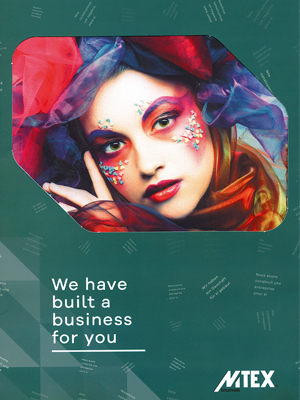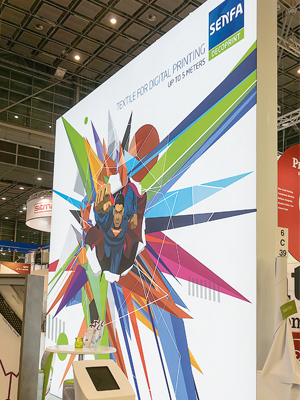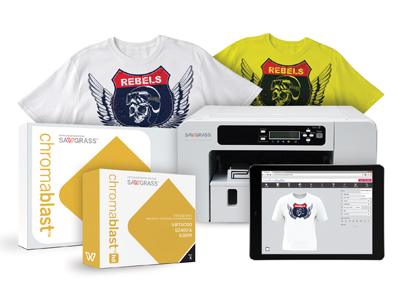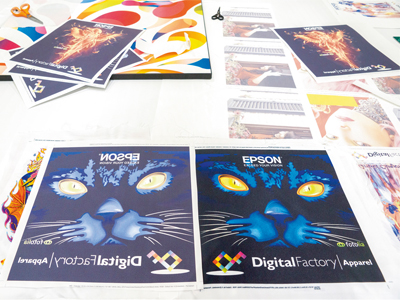Epson Dye sub transfer before and after
Adding textile printing is a diversification strategy with surprisingly modest entry costs, finds Simon Eccles.
Companies casting around for new opportunities could usefully focus on textiles. The demand for short runs and personalisation is strong, while the range of applications is surprisingly high. Digitally printed textiles are all around, from the obvious (t-shirts and logo-emblazoned work wear) to personalised soft furnishings and wall coverings, flags and banners, to variations on existing sign and display uses. Retail and exhibitions increasingly use ‘soft signage’ as it is easy to transport,
can be re-used.
Direct-to-garment
Digital textile printing methods are broadly split into direct-to-garment (DTG) or roll-to-roll (RTR). DTG means printing straight onto finished items, often shirts. Dedicated DTG printers tend to be special flatbed inkjet printers. They use pigment inks, which are suitable for cottons and other natural fibres, fixed by heat presses. ‘For a printing business looking to diversify into textile printing, direct-to-garment offers a convenient path,’ said Maneesh Patel, managing director of DTG Solutions in Beckenham. ‘This has lowered the barriers to entry to textile printing. Specifically, in apparel printing, DTG enables printers to produce short run trials and custom designs. ‘The great thing is flexibility, because short runs don’t incur the increased costs and therefore switching from one product to another is a simple and quick process.’He adds that scaling up is easy by adding more printers.
The Epson SureColor FC-2000 introduced a few years ago counts as entry level in the DTG market, priced about £15,000 for a five colour model with white ink. Printing takes a minute per garment and is suitable for run lengths of up to 50. A suitable heat press costs £2000 and will fix a t-shirt in 45 to 60 seconds. Above the entry level, the sky’s the limit with greater throughput and size. Kornit has a range of machines starting with the Breeze at £40,000 with a throughput of up to 40 light coloured garments per hour, or 25 if they are dark. Kornit’s NeoPigment ink is suitable for cotton, cotton-polyester blends, Lycra, leather, denim, silk and wool.
Roll to Roll
RTR goes onto rolls of cloth that are later cut, sewn and finished into garments, soft furnishings, curtains, drapes, wallcoverings, flags, banners and soft signage. Finishing is always needed, whether it is a seam to prevent fraying, or complex cutting and sewing of garments and soft furnishing that will probably have to be outsourced or left to the customer. Purpose-built textile printers from D-Gen, Durst, Kornit, Robustelli (maker of the Monna Lisa series printers sold by RA Smart) and Reggiani (recently acquired by EFI) are industrial strength (and price) machines designed from the ground up for textiles. General-purpose inkjet manufacturers, Epson, Mimaki, Mutoh, and Roland DG offer lower cost and throughput machines. Purpose designed textile printers have also been released by all these manufacturers, most recently the 1.8 metre Mimaki Tx300P-1800. Price has yet to be announced but it replaces the Tx2 model, which cost £25,000.
Ripping a toe in
Steven Woodall, national sales manager for textiles and apparel at Mimaki’s UK distributor Hybrid Services, said that soft signage is a common first move into textiles.
‘It was previously confined to specialist trade services, but subcontracting is expensive – for example if you’re sending out £80,000 to £90,000 per year of business it is worth keeping in-house. ‘Mtex is a Portuguese firm producing RTR digital inkjet textile printers with integral inline infrared post-print heaters to sublimate and fix the ink. Its range includes the entry-level Blue, a 1.8 metre wide inkjet intended for direct dye sublimation printing costing £44,950. At drupa, the firm’s theme was ‘to de-mystify textiles,’ according to UK managing director Stewart Bell. ‘It is seen as a black art and a long process. We were trying to show what products people could sell. Our typical client is in signage and already has eco solvent and wants to try flags or banners. But textiles are very versatile, they are not just for banners – you need to have an open mind. A display textile with a soft feel could also be used for cushions, just by sewing.
On our stand we used standard display textile for the cushions.’ The company brochure ‘We have built a business for you,’ shows typical applications with descriptions of the amount of ink and media needed, such as for a sofa, seat cushions, wall coverings and display frames, together with contact details for textile and Rip suppliers.

Mtex cover
Additional opportunities
‘The biggest opportunity in fabric printing used to be high end sportswear, now it’s being used more and more for test marketing runs,’ said Neil Greenhalgh, product manager for Prographics at Epson UK. For production work Epson offers the 64 inch SureColor SC-F9200 dye sublimation printer at just under £15,000. For samples of smaller items, such as cushions, the smaller SC F6200 would be suitable and is under £5000.
Ink choice
Some standard signage and graphics inks work on textiles, though they usually need pre-treatment and the excess needs to be washed off afterwards. UV-cured inks – provided they are fairly flexible – work for some banners and soft signage but can’t be used for anything that touches skin or food. Dye sublimation is common and easy to use either with transfer papers or direct to roll, and then permanently fix with heat. This is often called disperse dye when used for direct printing. It produces bright permanent colours that are chemically bonded to the fibres, but it requires a high proportion of polyester in the textile.

Senfa giant backlit textile at drupa
Pigment inks will work with cottons and other natural
fibres. They are likewise fixed by heat, but are not as wash-proof as dye sublimation. High-end clothing applications need more specialist acid and reactive inks, with the decision depending on the composition of the fabric.
‘It would be unusual for a sign printer to go into reactive dye or acid ink,’ said Mr Woodall. ‘Those are for specialised garment printers. I don’t know of any UV or solvent print houses that would go for reactive or acid dye. They need a different skill set.’
Third party inks play a greater part in textile printing than in graphics work. Bordeaux Inks recently introduced Eden PG, a pigment ink that it claims is suitable for any textile type.
‘As the problem with textile printing lies in the inks, then the solution must come from the chemistry,’ noted Guy Evron, marketing director of Bordeaux. ‘Five years ago we said we need one ink for all textiles. We thought it impossible, but our CEO and R&D pushed it through.’
Additional material
Sawgrass has long specialised in dye sublimation inks and holds many key patents. It concentrates on packages of small printers and inks for the short run commercial market. Entry-level transfer printing systems, such as the Virtuoso HD Product Decorating System, cost between £500 and £1250. These include SG400 (A4) or SG800 (A3+) printers, SubliJet-HD sublimation ink, CreativeStudio online design and printer software, all-in-one support and resources to help with production, sales and marketing.

Sawgrass kit Virtuoso-CBHD-SG400-PRC
While sublimation may seem as limited by its requirement for polyester Sawgrass argues that advances in polyester production are changing that. Spun polyester, which has the look and feel of cotton, and all the properties needed for sublimation is revolutionising the market. As are a wider range of substrates including microfibre, sweatshirt fabric, poplin, satin, silk, canvas, mesh, duck and fleece. The firm promotes an additional benefit of sublimation, which is that it can be applied not only to fabric decoration, but also to hard surface products, so companies that choose this method of digital printing are getting much more from their investment than from any other option available.
In conclusion, textiles can be a valuable addition to an existing digital print business, especially if you already have some wide format customers. Large format graphics and signage are the most natural extension for anyone already involved in banners, posters and signage. Direct to garment is best approached on a small scale initially, offering T-shirts or branded work and sportswear to local businesses, schools and clubs for instance. However, once the business starts rolling in there’s potential for it to become a real money-spinner.





